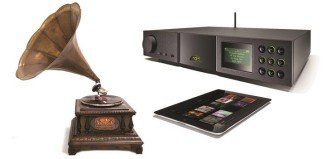It is now well known that turntables are making quite a strong comeback in the world of high-end audio. What is less well known is that a stable mate of turntables during their golden age, tubes, are also making a feisty comeback.
Most non-audio enthusiasts still regard tube amplifiers as relics of an age gone by, something that belongs in a museum. If these folks were to attend shows like TAVES or RMAF, I am sure they would be surprised to see many speaker manufacturers using tube rather than solid-state amplifiers to demonstrate their speakers to show visitors. This is a testament to the performance of well-designed tube amplifiers.
When I have guests at home, many of them look at my tube amplifier and ask me if I collect vintage audio equipment. Imagine their surprise when I explain to them that tube amplifiers are back with a vengeance and that some of the best performing amplifiers available today are based on tubes.
I then play them some tunes via my tube amplifier and most of them can easily detect the warm and seductively smooth quality of the reproduced sound, which is very difficult to obtain even with very good quality solid-state amplifiers. This is exactly why so many audio enthusiasts are now gravitating towards tube amplifiers despite the hassle and expense of having to change tubes periodically.
One confusing aspect about tube amplifiers is the way you gauge their power output. In this regard they differ from their solid-state counterparts. For example a 50 watt tube amplifier will probably drive your speakers to the same loudness levels as a 100 or even 120 watt solid state amplifier.
Tube amplifiers also tend to be less tolerant of fluctuations of speaker impedance than solid-state amplifiers. In many cases, a solid-state amplifier, will double its power to the speakers when the impedance is halved. This is not always the case with tube amplifiers. This means that you have to be a lot more careful when matching tube amplifiers with speakers, especially if you have or plan to buy speakers that have widely varying impedance properties.
Tube amplifiers fall mainly into two categories, i.e. single ended or push pull. Let’s look at the difference between the two. With a single ended configuration you have one power tube per channel, usually a triode type tube. Amplifiers with this configuration are usually relatively low powered models and need to be matched up with very high efficiency speakers to compensate for the low power output. These amplifiers tend to sound very sweet and pleasing to the ear and to many tube fans, offer the ‘authentic’ sound of tubes.
A single ended design could also use various tubes per channel connected in parallel mode. This configuration is known as a parallel single-ended design and it is used to obtain more output power per channel.
In the push-pull tube amplifier configuration, two power tubes are employed per channel, thus doubling the power output of the amplifier. This design tends to use tetrodes or pentodes. The character of tube amplifiers employing this design still sounds sweet and smooth while offering the advantage of more output power, thereby making them compatible with a greater range of speakers.
Some diehard single ended tube amplifier design fans firmly believe that the push-pull design does not deliver sound quality as good as a single ended design. You should let your ears be the arbiter to settle this. To my ears, the push-pull design does sound a bit different to the single ended design but not necessarily worse.
Most tube amplifiers fall into either class A or class AB configuration. Generally, most power triodes work in class A and in this configuration, most of the amplifier’s energy is dissipated as heat and the output power is relatively low. The sound quality of this class is very high, but they run extremely hot.
A typical design of a class A amplifier will consume a lot of electricity and generate enough heat to force you to turn your air-conditioning unit up a few notches, but the sound of this configuration, when well implemented, is so sublime, many audio enthusiasts think the trade-off is worth it.
A more common class of tube amplifiers is class AB. In this configuration the design is more efficient and makes better use of the electricity consumed. This means that more of the electric current is converted into power that is sent to the speakers. The probable trade-off here is that the sound may not be as refined as a pure class A configuration.
If you are just testing the waters with regard to tube amplifiers, I would suggest that you opt for a push-pull type model with around 40 watts of power output. This would be roughly equal to the power output of a solid-state amplifier with 70 to 90 watts of power and if you have speakers that are relatively efficient (better than 89 dB sensitivity) it should provide you with plenty of power to play your music loud enough to rattle your windows.
One of the key parts of any tube amplifier is its output transformer. It plays a very important part in determining the ultimate sound quality you get from the amplifier. When shopping for a tube amplifier, ensure that it uses a high quality output transformer.
Some of the better brands of output transformers are Hammond, Bartolucci, Sowther, UTC, One Electron, Magnequest, Tamura, Lundahl and Electra Print. In some cases, tube amplifier manufacturers design and build their own output transformers or have them designed by an established manufacturer to their specifications.
When auditioning a tube amplifier, lightly touch the output transformer after about 30 minutes of listening. If it is too hot to touch, it could signify that it is working under a lot of stress, which could shorten the life of the transformer. It is important that your tube amplifier has a high quality power transformer. Here again, it should work without getting too hot. Some of the better brands use an oversized power transformer so that it is not pushed to its limits during operation thus extending its life.
So what should you be looking for inside a tube amplifier? Before we get into that, let me lay down a caveat. This needs to be done with the utmost care, as there are lethal voltages inside the amplifier. It is also important to check the manufacturer terms and conditions because in many cases, opening the amplifier could void the manufacturer warranty.
If you are willing and able to look inside the tube amplifier here is what to watch out for. Ideally the circuits should be wired and soldered from one point to another rather than the more common and cheaper to implement printed circuit boards. If you find that the tubes are soldered to a printed circuit board, you may be better off looking at another model.
There are not too many parts in most tube amplifiers, basically resistors and capacitors, but these should be good quality from a reputable brand. Some of the brands that you can trust for high and consistent quality are Duelund, Holco, Wima, Sprague, Hovland, Jensen, Alps, Noble, Cardas and Kimber.
When auditioning a tube amplifier look for models that have a sweet, smooth sound that has very little listening fatigue, so that even after listening to it for an hour, it leaves you wanting more.
Unlike solid-state amplifiers, you can tweak the sound of many tube amplifiers by changing to a different model of tube. This is as easily done as changing a light bulb. With solid-state amplifiers this is a lot more difficult to accomplish because you need a soldering iron and some expertise on how to use it to change transistors and other solid-state devices.
In general, solid-state amplifiers tend to be better than their tube counterparts when it comes to dynamics and control of the bass notes in the music, but well designed tube amplifiers are usually superior in reproducing the critical mid-range sounds which make up most of the music.
Let us now examine some of the myths surrounding tube amplifiers. There is a general perception that tube amplifiers are more difficult to maintain than their solid-state counterparts. This is not necessarily true. All you need is a soft, preferably cotton cloth to keep a tube amplifier dust free. Dust will diminish the performance of a tube amplifier and so a periodical cleaning is recommended.
It is also thought that tubes are difficult to handle. This is also a myth, although a pair of gloves is recommended to avoid grease from your fingertips from getting on the tubes, which will again, compromise the performance.
It is true that tube amplifiers are fussier about speakers than solid-state amplifiers. However if your tube amplifier outputs over 40 watts per channel and you own or choose speakers that have higher than average sensitivity (over 89 dB) you should be all right.
All things being equal, it is usually cheaper to build a high-powered (over 100 watts per channel) solid-state amplifier than a tube amplifier with the same output. On paper, generally speaking, tube amplifiers tend to have lower outputs than equivalently priced solid-state amplifiers. However, you should not take those figures at their face value. You should carefully audition the amplifiers and let your ears tell you if the models you are considering, have the required power output for your needs.
There is also the perception that tubes are harder to find than transistors. This may be true for certain models of tubes but the more commonly used models like the E34L are widely available. For better performance, the tubes you use should be matched pairs for each of the two stereo channels. Many tube amplifier manufacturers offer customers matched pairs when it is time to replace the tubes. This service may cost you more, but it is worth it, as matched tubes will optimize the performance of the amplifier.
Another perception is that tubes need to warm up for around 30 minutes before they sound their best, whereas solid state amplifiers will sound good with just 5 to 10 minutes of warm up time. This is true and although it might be a hassle, it is advisable to let a tube amplifier warm up for at least 20 minutes before you begin critical listening.
Yet another perception is that hybrids of tubes and solid-state are a compromise. This varies on a case-by-case basis and so you will have to hear and compare hybrids to pure tube designs and trust your ears to decide what is better for you.
It is a myth that tube amplifiers are expensive. Just like solid-state amplifiers, tube amplifiers come in a wide price range and don’t be surprised if some of the more affordable models outperform equivalent priced solid-state amplifiers.
Many audiophiles prefer to buy classic tube amplifiers made in the last century, as they believe that they sound better than their modern counterparts. While this may be true in some cases, the downside to buying classic models is that they may be designed to use tubes, which are no longer in production and so may be difficult to procure when it is time to replace the tubes.
Bottom line; don’t be afraid to dip your toes into the ‘tube’ waters. Like so many audio enthusiasts today who decided to do so, you might just be glad you did.







